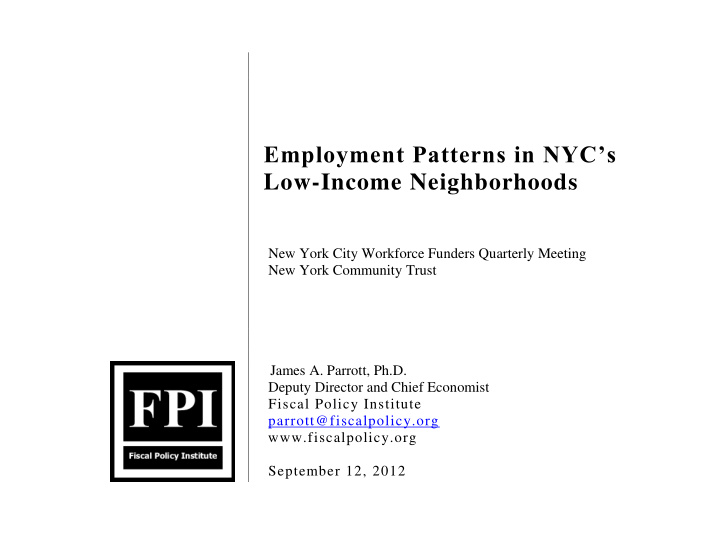



Employment Patterns in NYC’s Low-Income Neighborhoods New York City Workforce Funders Quarterly Meeting New York Community Trust James A. Parrott, Ph.D. Deputy Director and Chief Economist Fiscal Policy Institute parrott@fiscalpolicy.org www.fiscalpolicy.org September 12, 2012
Snapshot of the Current Economy NYC’s job growth better than the nation’s but unemployment remains very high in this historically weak “recovery” . The reported unemployment rate might be over-stated , but unemployment still much higher than before the recession. Caveats on job growth — most is low-wage, and population has grown since recession began so it is not sufficient to just re-coup lost jobs. Unemployment uneven — much higher for blacks, Latinos and young workers. Unemployment highest in low - income neighborhoods. Employment in NYC’s Low -Income Neighborhoods FPI 1
Where are NYC’s low -income communities? Using 2010 American Community Survey, identified the 17 (out of 55) neighborhoods with the lowest median household incomes ($40,000 and below.) These 17 low-income neighborhoods located in 4 areas: o Central and South Bronx o Harlem and Morningside Heights o Central and East Brooklyn o Sunset Park and Borough Park Brooklyn One-quarter of NYC population, but 48 percent of those in poverty. Poverty rates average about twice the rest of the city. Also one-quarter of NYC resident employment (900,000). Employment in NYC’s Low -Income Neighborhoods FPI 2
Employment by broad sector, 2010 17 Low-income All other neighborhoods neighborhoods Employment in NYC’s Low -Income Neighborhoods FPI 3
Median earnings for all jobs (full- and part-time) held by NYC residents were $32,000 in 2010 Some low-income neighborhoods have median earnings in the middle range ($30,000-$35,000) because they have relatively high shares (for low-income areas) of high-paying white collar or public administration jobs. o For example, Central Harlem has median earnings of $32,000 because of high job shares in Information, Professional Services, and Public Admin. o No. Crown Heights has median earnings of $35,000 as a result of high job shares in Information and Finance coupled with low job shares in the low- paying sectors of retail, food services and other services. On the other hand, some neighborhoods in the middle tier by income (median household income in the $45,000 ballpark), have median earnings in the low range ($22,000-$25,000). These neighborhoods (Washington Heights, Jackson Heights, and Elmhurst/Corona) tend to have high job shares in food and other services. These areas tend to have many recent immigrants and immigrant families in NYC, on average, have more workers than native families. Employment in NYC’s Low -Income Neighborhoods FPI 4
The importance of jobs in Health-Education-Social Services to NYC’s low -income neighborhoods Most significant employer in low-income communities, and a large employer of people of color and immigrants. From our May report on non-profit health and social services: 80% of the workforce is female and 80% persons of color, and the sector increased jobs by 20% from 2000 to 2011. Overall median wages right in the middle across all industries — although this reflects a broad range from low-wage home health care to high-wage doctors. Nearly two-thirds of workers in this sector work within their own borough. Residents of low-income neighborhoods who work in high-wage sectors are much more likely to commute to another borough. Health-Education-Social Services is the largest employer in the outer boroughs: from 23% of jobs in Queens to 41% in the Bronx. Blue collar jobs are prominent in Queens and low-wage services and retail together account for 22-23% of jobs in the Bronx, Brooklyn and Queens, and 32% in Staten Island. Employment in NYC’s Low -Income Neighborhoods FPI 5
Recommend
More recommend